Campuses are ground zero in debates about antisemitism − but that’s been true for 100 years
- Written by Jonathan Krasner, Associate Professor of Jewish Education Research, Brandeis University
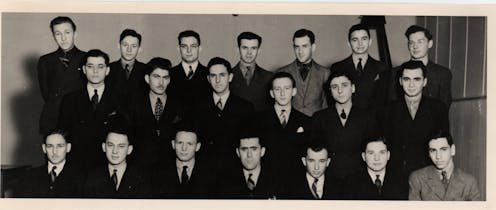 Members of Mu Beta Chi, a Jewish fraternity, at the University of Minnesota in 1936. Upper Midwest Jewish Archives, University of Minnesota, CC BY-ND
Members of Mu Beta Chi, a Jewish fraternity, at the University of Minnesota in 1936. Upper Midwest Jewish Archives, University of Minnesota, CC BY-NDWhen Eliza arrived on her West Coast college campus in the fall of 2020, building community was difficult due to the raging COVID-19 pandemic. Yet over time she forged a network of friends, anchored by her sorority.
Three years later, those relationships were severely tested by events over 7,000 miles away: the Oct. 7, 2023, terrorist attack in Israel and the ensuing war in Gaza.
Due to her support for Israel, she was ostracized by people she once considered close friends, including her sorority sisters. Walking around campus, she removed her Star of David necklace. To be clear, Eliza was not concerned about her physical safety. But she sensed a social penalty for being Jewish and wanted to avoid dirty looks and political confrontations.
As the civilian death toll in Gaza mounted, progressive campus activists, including some Jews, fervently adopted the Palestinian cause as an extension of their battles for racial and social justice. Opposition to the war has become a generational cause for earnest Zoomers, akin to the Vietnam War for baby boomers and opposition to South African apartheid for Gen Xers.
Critics contend that protesters are unfairly holding Jewish classmates accountable for the actions of the Israeli government – especially since Jewish Americans are not unified in their attitudes about the war and very few hold dual citizenship in Israel. Where protesters see manifestations of anti-Zionism – opposition to the existence of a Jewish nation state in present-day Israel – many Jewish students, staff and parents see antisemitism, pure and simple.
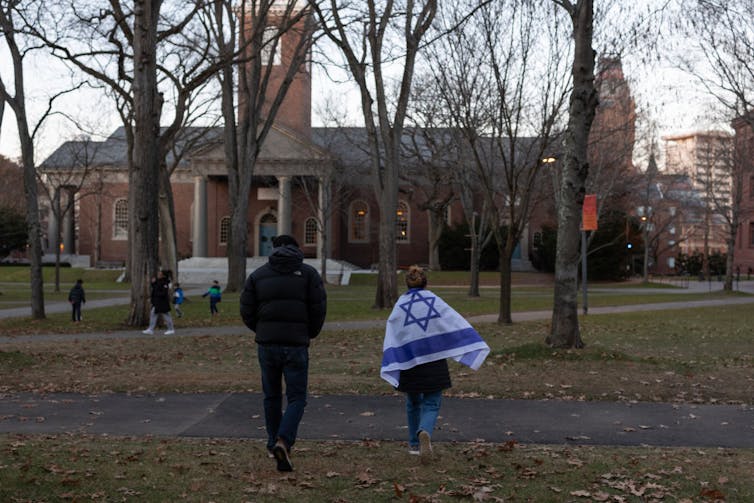 People attend a menorah lighting ceremony on the seventh night of Hanukkah in December 2023 in Harvard Yard.Andrew Lichtenstein/Corbis via Getty Images
People attend a menorah lighting ceremony on the seventh night of Hanukkah in December 2023 in Harvard Yard.Andrew Lichtenstein/Corbis via Getty ImagesEliza – a pseudonym, like all the student names in this article – was one of 36 undergraduates across the country whom I spoke with as part of a study of Jewish students’ responses to the conflict and its consequences. Their views on Israel and the war ran the gamut – but regardless, most felt unsettled by the death, abductions and destruction abroad, as well as the protests outside their dorms.
Many of them were surprised to find themselves wrestling with what it means to be Jewish in the U.S. and questioning their place in American society. But for more than 100 years, college campuses have been a testing ground for Jewish identity – and Americans’ acceptance of their Jewish compatriots.
Changing fortunes
The parents of today’s students, in particular, find themselves in a state of whiplash. Most attended college in the 1980s and ’90s, at the height of a golden age of Jewish life on American campuses. They view their children’s experiences not merely as a reversal but a betrayal.
“I went to college in the 1990s, and cannot recall a single moment when I felt uncomfortable as a Jew,” Sarah Hurwitz, a former speechwriter for the Obamas, recalled soon after the Oct. 7 attack.
Hurwitz’s alma mater, Harvard University, is embroiled in a lawsuit over allegations of antisemitism. Similar lawsuits were filed against Columbia University, UCLA and other schools. Meanwhile, federal investigations proceed over both antisemitic and Islamophobic incidents at dozens of colleges and universities.
Her recollections reflect many competitive colleges’ conscious efforts to welcome Jewish students in the 1980s and ’90s, such as by building new campus centers, offering an array of new Jewish studies courses and providing kosher dining options. In the 1990s, about 25% of undergraduates at Harvard and Yale claimed Jewish heritage. The numbers were even higher at Columbia and the University of Pennsylvania.
The trend was not confined to the Ivy League. Similar demographic stories played out at schools such as Boston University, Washington University in St. Louis and Northwestern University in Chicago.
Jews not wanted
It was not always so.
A century ago, first- and second-generation Jewish Americans flocked to higher education, seeing a degree as a ticket into the middle class. In response, elite colleges and universities notoriously restricted Jewish enrollment.
While other schools deliberated about their “Jewish problem” in secret, Harvard President A. Lawrence Lowell publicly announced his university’s intention to admit fewer Jews, which made the front page of The New York Times.
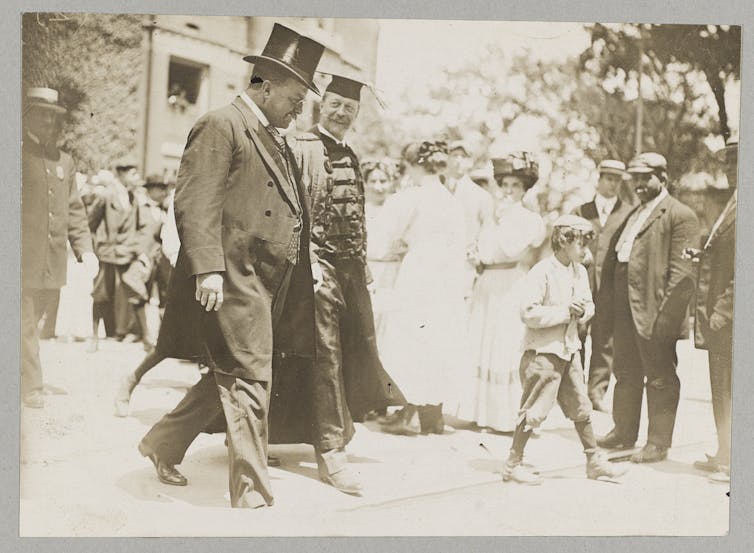 Harvard President A. Lawrence Lowell, right, walks with former U.S. President Theodore Roosevelt in 1910.Library of Congress
Harvard President A. Lawrence Lowell, right, walks with former U.S. President Theodore Roosevelt in 1910.Library of CongressExplaining the quota, Lowell essentially blamed the victims. Attributing a rise in antisemitic attitudes to Jews’ supposed “clannishness,” he argued that admitting too many Jews would impede Jewish assimilation and further heighten anti-Jewish sentiment.
Odious as his plan was, Lowell’s views were common. The “tribal twenties” was a time of widespread nativismand racism. As Harvard and other schools were instituting Jewish quotas, the U.S. Congress passed a restrictive immigration law that reduced Jewish immigration to a trickle.
Antisemitism was fueled by multiple and often conflicting conspiracy theories that appealed as much to cultured elites as to the unschooled.
Genteel antisemitism
On campus, antisemitism often manifested as social snobbery. For example, Greek organizations routinely discriminated on the basis of race and religion.
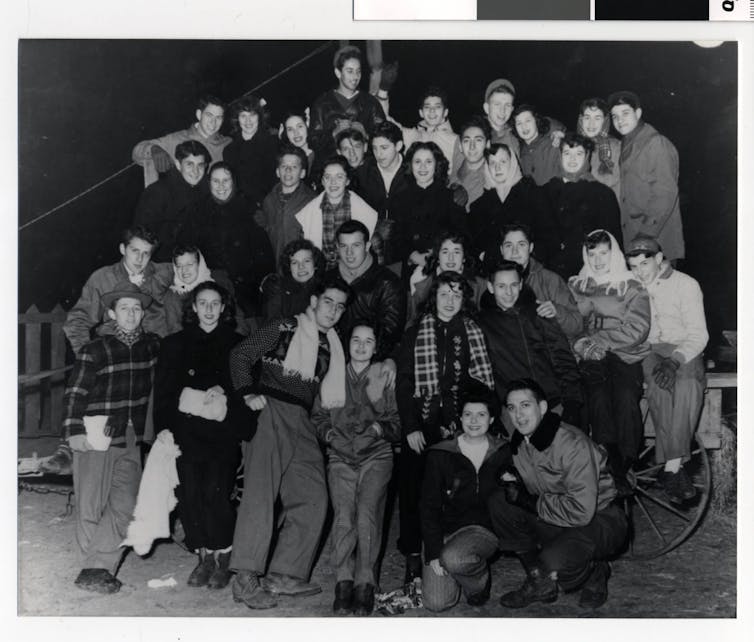 A Jewish fraternity and sorority gathering in Minneapolis, Minn., in 1949.Upper Midwest Jewish Archives, University of Minnesota, CC BY-ND
A Jewish fraternity and sorority gathering in Minneapolis, Minn., in 1949.Upper Midwest Jewish Archives, University of Minnesota, CC BY-NDMeanwhile, New York’s upper crust responded to an influx of Jewish students at Columbia by sending their sons to out-of-town institutions. Indeed, Lowell’s fear that Harvard would suffer Columbia’s fate and scare away the “Boston Brahmins” motivated his efforts to reduce his university’s Jewish presence.
Harvard students’ feelings about Jewish classmates were revealed in 1922 when a professor invited his class to share opinions about Lowell’s “race limitations” plan on their final exams. “The Jews tend to overrun the college, to spoil it for the native-born Anglo-Saxon young persons for whom it was built and whom it really wants,” one student wrote. “Jews are an unassimilable race,” concluded another, “as dangerous to a college as indigestible food to a man.”
Harvard ultimately adopted a more indirect but equally effective plan to curb Jewish enrollment that capped the number of undergraduates and emphasized geographic diversity. Specifically, it admitted fewer students from Northeastern cities with large Jewish populations, while expanding its program of legacy admissions. From 1921 to 1928, Jewish enrollment dropped from over 21% to Lowell’s original target of 10%.
Other schools followed suit. As late as the 1950s, universities were designing their own restrictive admissions policies.
Fitting in − or not
Jewish college students realized that the genteel antisemitism they experienced on the quad was a taste of the discrimination they would face on the job market. Many compensated for the prejudice around them by avidly Americanizing, even by legally changing their names. By midcentury, many Jewish teens and young women were “whitening” themselves by getting nose jobs and straightening their hair.
As much as they tried to blend in, many continued to feel disaffected. As historian Daniel Greene noted, they inhabited an in-between space: a conflicted middle ground between their American and Jewish identities, never fully at home in either world.
Others immersed themselves in Jewish life. Some were attracted to Zionism, then a relatively new movement that supported a Jewish national home in the region of Palestine, the biblical land of Israel. Many joined Jewish fraternities and sororities or campus groups. The first chapter of Hillel, presently the largest Jewish campus organization, was founded at the University of Illinois in 1923.
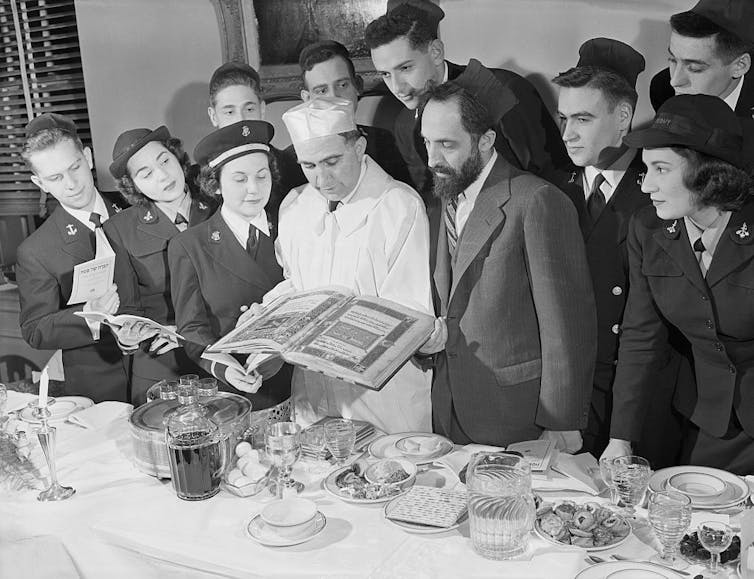 Jewish members of the armed forces from Columbia University prepare for a Passover Seder service at the Jewish Theological Seminary of America in 1944.Bettmann via Getty Images
Jewish members of the armed forces from Columbia University prepare for a Passover Seder service at the Jewish Theological Seminary of America in 1944.Bettmann via Getty ImagesThe climate for Jewish students improved in the late 1950s and ’60s, as elite schools, beginning with Harvard, adopted admissions policies that prized academic merit, reflected primarily in SAT scores. In the words of journalist Sarah Leonard, universities shed “a portion of academically mediocre bluebloods in favor of scrappier kids with impressive test scores.”
Now versus then
It is tempting to compare the contemporary experiences of Jewish students with those of a century ago. And there are similarities, to be sure. Inevitably, some students are galvanized to action, while others prefer to melt into shadows. Some turn inward and find comfort in community, while others challenge themselves to adapt to the disequilibrium.
But there are also significant differences, including that Jewish Americans wield far more political power as a group than they did in the 1920s.
The spectacle of university presidents being hauled before a U.S. congressional committee in 2023 over accusations of antisemitism on their campuses may have been a political ploy by Republicans. In part, it underscored the GOP’s alliance with evangelical Christian supporters of Israel and its desire to attack institutions of higher education as “woke.” Yet it also signaled that Jews enjoy a level of influence in the halls of government that would have baffled their great-grandparents.
Many parents and students are dissatisfied with campus leaders’ responses to the anti-Israel protests. But their concerns have been afforded a level of consideration that was almost entirely absent in earlier times. Consider the swiftness with which Columbia dismissed three mid-level administrators in July 2024, after images of snarky text messages trafficking in antisemitic tropes were leaked to the media.
In recent months, some students like Eliza may be downplaying their Jewishness to diffuse tense situations. But that does not mean they are rejecting their identities.
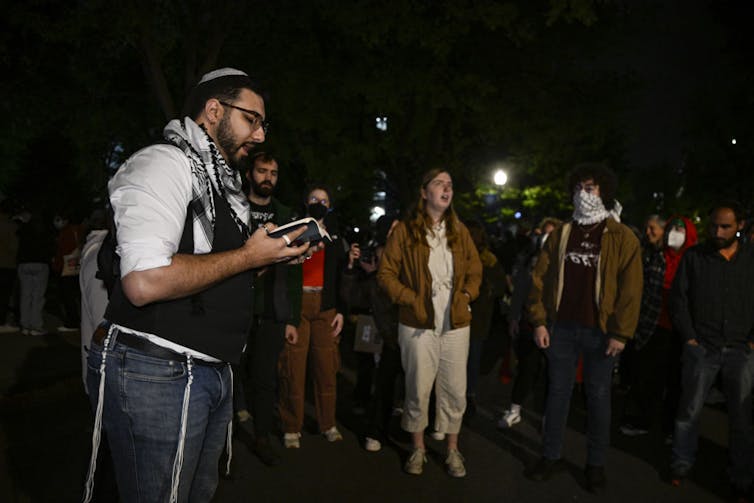 Jewish students and allies hold a Shabbat event and prayer in solidarity with the pro-Palestinian encampment at George Washington University on April 26, 2024.Celal Gunes/Anadolu via Getty Images
Jewish students and allies hold a Shabbat event and prayer in solidarity with the pro-Palestinian encampment at George Washington University on April 26, 2024.Celal Gunes/Anadolu via Getty ImagesEven Jewish students who support the campus protests often frame their concern for Palestinian life in terms of their Jewish values. Ava, a student I interviewed at an East Coast university, no longer feels comfortable attending Sabbath services, due to the campus rabbi’s pro-Israel politics. Yet she finds Jewish connection through a Jewish anti-Zionist organization led by students.
Ezra, a student leader at the Hillel chapter on a particularly volatile campus, bemoaned some protesters’ excesses. He had little patience for white progressive activists spouting slogans like “Globalize the Intifada!” without understanding their meaning. But he evinced greater sympathy for Arab and Muslim demonstrators, especially those who had been personally touched by the death and devastation in Gaza.
Ezra viewed their activism as a form of “punching up.”
“We have a Hillel house – probably one of the nicest in the country – and the ear of the administration through donors and alumni,” he explained. “We’re fighting to maintain our privilege while they’re fighting for representation.”
Jonathan Krasner does not work for, consult, own shares in or receive funding from any company or organization that would benefit from this article, and has disclosed no relevant affiliations beyond their academic appointment.
Authors: Jonathan Krasner, Associate Professor of Jewish Education Research, Brandeis University

